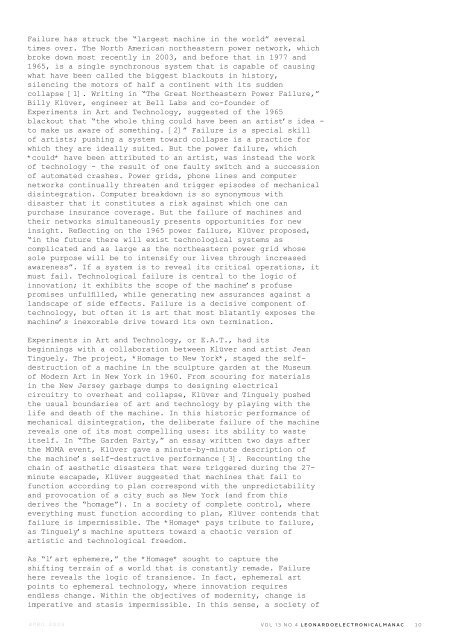Leonardo Electronic Almanac / Volume 13, No. 4 / April
Leonardo Electronic Almanac / Volume 13, No. 4 / April
Leonardo Electronic Almanac / Volume 13, No. 4 / April
Create successful ePaper yourself
Turn your PDF publications into a flip-book with our unique Google optimized e-Paper software.
Failure has struck the “largest machine in the world” several<br />
times over. The <strong>No</strong>rth American northeastern power network, which<br />
broke down most recently in 2003, and before that in 1977 and<br />
1965, is a single synchronous system that is capable of causing<br />
what have been called the biggest blackouts in history,<br />
silencing the motors of half a continent with its sudden<br />
collapse [1]. Writing in “The Great <strong>No</strong>rtheastern Power Failure,”<br />
Billy Klüver, engineer at Bell Labs and co-founder of<br />
Experiments in Art and Technology, suggested of the 1965<br />
blackout that “the whole thing could have been an artist’s idea -<br />
to make us aware of something. [2]” Failure is a special skill<br />
of artists; pushing a system toward collapse is a practice for<br />
which they are ideally suited. But the power failure, which<br />
*could* have been attributed to an artist, was instead the work<br />
of technology - the result of one faulty switch and a succession<br />
of automated crashes. Power grids, phone lines and computer<br />
networks continually threaten and trigger episodes of mechanical<br />
disintegration. Computer breakdown is so synonymous with<br />
disaster that it constitutes a risk against which one can<br />
purchase insurance coverage. But the failure of machines and<br />
their networks simultaneously presents opportunities for new<br />
insight. Reflecting on the 1965 power failure, Klüver proposed,<br />
“in the future there will exist technological systems as<br />
complicated and as large as the northeastern power grid whose<br />
sole purpose will be to intensify our lives through increased<br />
awareness”. If a system is to reveal its critical operations, it<br />
must fail. Technological failure is central to the logic of<br />
innovation; it exhibits the scope of the machine’s profuse<br />
promises unfulfilled, while generating new assurances against a<br />
landscape of side effects. Failure is a decisive component of<br />
technology, but often it is art that most blatantly exposes the<br />
machine’s inexorable drive toward its own termination.<br />
Experiments in Art and Technology, or E.A.T., had its<br />
beginnings with a collaboration between Klüver and artist Jean<br />
Tinguely. The project, *Homage to New York*, staged the selfdestruction<br />
of a machine in the sculpture garden at the Museum<br />
of Modern Art in New York in 1960. From scouring for materials<br />
in the New Jersey garbage dumps to designing electrical<br />
circuitry to overheat and collapse, Klüver and Tinguely pushed<br />
the usual boundaries of art and technology by playing with the<br />
life and death of the machine. In this historic performance of<br />
mechanical disintegration, the deliberate failure of the machine<br />
reveals one of its most compelling uses: its ability to waste<br />
itself. In “The Garden Party,” an essay written two days after<br />
the MOMA event, Klüver gave a minute-by-minute description of<br />
the machine’s self-destructive performance [3]. Recounting the<br />
chain of aesthetic disasters that were triggered during the 27minute<br />
escapade, Klüver suggested that machines that fail to<br />
function according to plan correspond with the unpredictability<br />
and provocation of a city such as New York (and from this<br />
derives the “homage”). In a society of complete control, where<br />
everything must function according to plan, Klüver contends that<br />
failure is impermissible. The *Homage* pays tribute to failure,<br />
as Tinguely’s machine sputters toward a chaotic version of<br />
artistic and technological freedom.<br />
As “l’art ephemere,” the *Homage* sought to capture the<br />
shifting terrain of a world that is constantly remade. Failure<br />
here reveals the logic of transience. In fact, ephemeral art<br />
points to ephemeral technology, where innovation requires<br />
endless change. Within the objectives of modernity, change is<br />
imperative and stasis impermissible. In this sense, a society of<br />
APRIL 2005 VOL <strong>13</strong> NO 4 LEONARDOELECTRONICALMANAC 10



